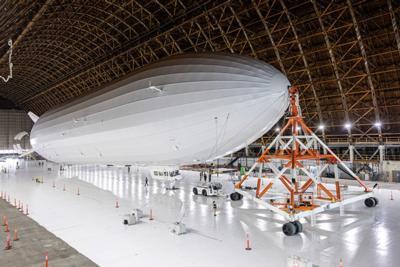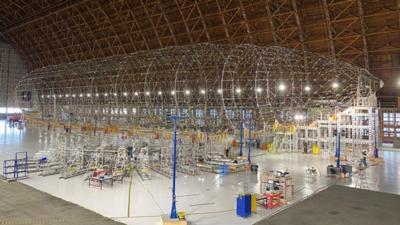Flight Testing of LTA Research Vessel to Commence
In 2015, Google co-founder Sergey Brin founded Lighter Than Air (LTA) Research for purpose of advancing airship technologies and fostering the design, development, and construction of a new generation of ecologically conscious flying machines.

The aircraft borne of Brin’s investment and the diligent work of skilled personnel split between Akron, Ohio; Mountain View, California; Gardnerville, Nevada, and the LTA’s Palo Alto, California headquarters has been ascribed the apposite moniker Pathfinder 1, and was recently granted a special airworthiness certificate by the Federal Aviation Administration.
The certificate authorizes LTA to fly Pathfinder 1 within the conjoined Class “D” airspace of northern California’s Moffett Federal Field (NUQ) and neighboring Palo Alto Airport (PAO).
In a letter supporting its application for the certificate, LTA set forth: “Pathfinder 1’s experimental flight test program is to demonstrate and establish the flight envelope for the airship…. LTA’s test plan is tailored to include substantial indoor and outdoor ground testing, using a build-up approach to gradually increase the flight envelope.”
Initial ground-testing will see the immense airship tethered to a mobile outdoor mast; a series of approximately 25 low-altitude flights totaling some fifty-hours will follow.
While its rigid architecture is evocative of the immense airships of the early 20th century, the three-thousand titanium hubs and ten-thousand carbon-fiber-reinforced polymer tubes of which Pathfinder 1’s subframe consists mass so little that the aircraft can be borne aloft by inert helium—as opposed to hydrogen, the reactivity of which was infamously demonstrated in Lakehurst, New Jersey on 06 May 1937.

By way of thrust, Pathfinder 1 is motivated by a hybrid-electric propulsion system comprising two 150-kilowatt diesel generators and 24 storage batteries supplying power to no fewer than 12 electric-motor/rotor assemblies distributed about the airships lateral perimeter. Directional control is via four aft-mounted fin-rudder assemblies. So powered, Pathfinder is capable of Vertical Take-Off and Landing (VTOL) and forward speeds of up to 64-knots.
Pathfinder 1’s lift scheme comprises an outer-skin of laminated Tedlar containing 13 helium bags fashioned from ripstop nylon. The gas levels within the latter are tracked by discrete LIDAR (Light Detection And Ranging) systems. A DuPont product, Tedlar is a high-performance Polyvinyl Fluoride Film (PVF) film used throughout the aerospace industry.
LTA CEO Alan Weston posits future iterations of the company’s airships may use hydrogen as both a lifting gas and a fuel for near-future hydrogen fuel-cell-powered propulsion systems.

Though designed for single-pilot operation, Pathfinder 1 is equipped with dual pilot stations and redundant flight controls. According to an LTA correspondence with the FAA, the test aircraft will be crewed by two pilots “for initial flight testing until pilot workload can be assessed.” The gondola with which LTA has provisioned Pathfinder 1 was designed by Germany’s storied Zeppelin company, and can accommodate up to 14 occupants.
LTA aspires to see its aircraft plied to humanitarian cargo-carrying missions to locales inaccessible by road.
Notwithstanding LTA’s assertions that the Pathfinder 1 flight-testing campaign will span only 180 days, the special airworthiness certificate issued by the FAA is reportedly valid for a period of one-year.
 Aero-News: Quote of the Day (12.18.25)
Aero-News: Quote of the Day (12.18.25) Classic Aero-TV: Viking Twin Otter 400--Bringing the DHC-6 Back Into Production
Classic Aero-TV: Viking Twin Otter 400--Bringing the DHC-6 Back Into Production NTSB Final Report: Rans Employee Flying Club Rans S-6ES Coyote II
NTSB Final Report: Rans Employee Flying Club Rans S-6ES Coyote II ANN FAQ: Submit a News Story!
ANN FAQ: Submit a News Story! ANN's Daily Aero-Term (12.18.25): Braking Action Advisories
ANN's Daily Aero-Term (12.18.25): Braking Action Advisories





